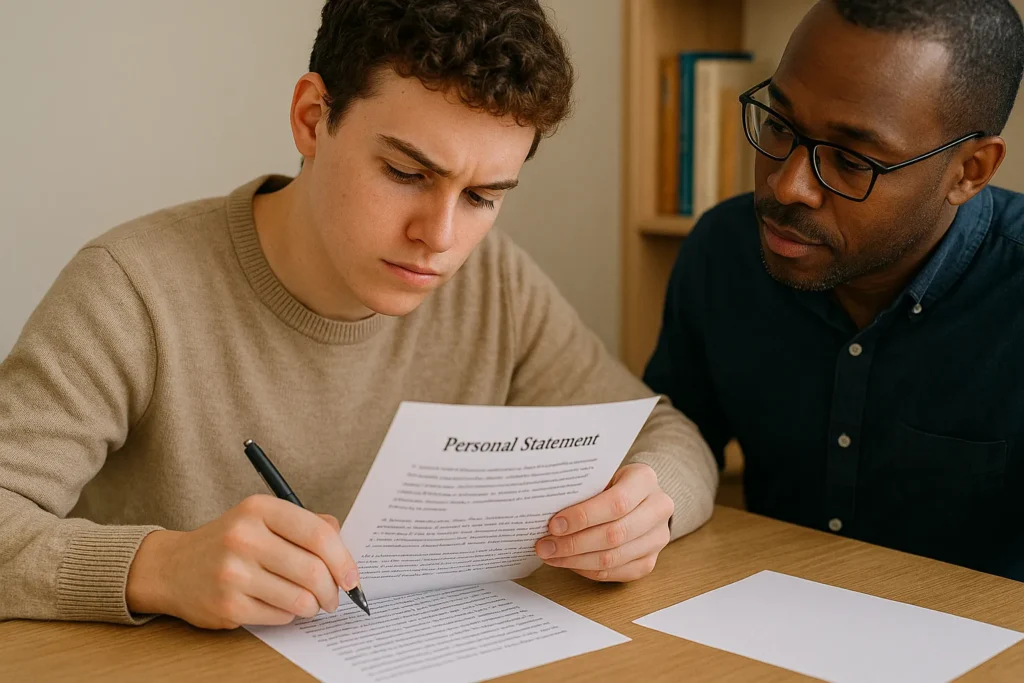Dreaming of studying overseas but unsure how to put your story into words? That first blank page can be the hardest part. A study abroad personal statement needs to sound genuine, show a clear purpose, and leave a strong impression on admissions teams.
Finding the right balance can feel tough. You want to sound confident, not try-hard. Honest, but not too personal. What works? What doesn’t?
This guide breaks it down simply. You’ll learn what to include, how to plan it, and which common mistakes to skip. Plus, we’ll share practical tips and examples most people forget to mention.
If you’re ready to write something that feels clear, honest and strong from start to finish, let’s get started.
Personal Statement: What It Is & Why It Matters
A study abroad personal statement is a short written piece that forms part of your university application. It gives admissions teams a clear view of who you are, what motivates you, and why you want to study in a new country.
Your academic record shows your performance, but a personal statement is your chance to demonstrate character and intent. Admissions teams often read between the lines.
They pay close attention to how clearly you express yourself, how well you’ve thought through your decision, and whether you seem prepared for the challenges of studying abroad.
So, what makes a personal statement unique from the rest? Let’s explore the main elements that build a strong, memorable application.
The Core Ingredients of a Strong Statement
A strong study abroad personal statement gives a clear picture of your purpose, plans, and personality. This short piece plays a major role in how universities assess whether you fit their programme.
When structured well, it shows that you’re focused, motivated, and ready for both academic and cultural challenges.

Here’s what admissions teams expect to see:
A Clear Reason for Studying Abroad
Explain what draws you to international study. Mention specific experiences, goals, or interests that influenced your decision.
This could be anything from a lifelong fascination with another culture to a career plan that requires international exposure. Make sure your reason sounds considered and not last-minute or vague.
Your Academic Background and Future Direction
Show how your previous studies connect with the course you’re applying for. Highlight subjects, projects, or areas of academic interest that have prepared you for the next step.
Then, point to how this course helps move you closer to your long-term goals, whether that’s research, industry work, or further study.
Evidence of Personal Growth and Curiosity
Include an example that shows your willingness to step outside your comfort zone. This could come from travel, group projects, volunteering, or even handling setbacks.
These stories can show maturity, independence, and readiness to take on the challenges of living and learning in a new place.
A Strong Link Between the Course and Your Plans
Be clear about what the course offers and why it fits your vision. Mention modules, opportunities, or resources at the university that excite you. Then connect those features to your goals so the reader sees you’ve researched the course and know exactly how it suits your path.
From our experience, the most effective statements are those that stay focused, use clear language, and connect each point back to a well-defined goal.
What Makes Statements Stand Out
The best personal statements have a clear voice, a thoughtful structure, and a genuine tone. They read like someone who knows why they’re applying and where they’re going. Following a few simple “DOs” can take your statement from average to memorable.
Here’s what to focus on:
- Start with a story or moment that sparked your interest: A strong opening catches attention. Start with a real moment that triggered your curiosity or impacted your decision to study abroad. It doesn’t need to be dramatic, just meaningful. (Example: “During a two-week science exchange in Japan, I realised how much I enjoyed learning through a different academic lens. The way students approached problem-solving activated my interest in global collaboration and made me think seriously about studying internationally.”)
- Show self-awareness and growth: Don’t just list achievements and stop there. Reflect on them. What did you learn? How have your experiences affected your thinking? Statements with personal insight feel more grounded and believable. (Example: “After struggling with group projects in my first year of university, I started reading about team dynamics and communication. By my third year, I led a project that won a faculty award. That experience taught me how much growth comes from discomfort.”)
- Include evidence to back up your goals: Admissions teams want to see that your plans come from real exposure instead of originating in vague ideas. Mention relevant coursework, projects, volunteer roles, travel or moments that pushed you forward. (Example: “While volunteering at a local refugee support centre, I developed a deeper understanding of cultural adaptation. Seeing the strength it takes to start over in a new country inspired me to explore social policy on a global scale.”)
These elements help your statement feel original, thoughtful and complete. Next, let’s cover the common mistakes that can ruin a good start.
Common Mistakes to Avoid
Even a strong idea can fall flat if it’s presented poorly. The mistakes below are surprisingly common and can instantly turn a great application into a forgettable one. However, the best part is that each one is easy to avoid with the right approach.

Let’s see what you should avoid doing:
- Using generic or cliché phrases: Lines like “I’ve always wanted to travel” or “This course is my dream” sound obscure and overused. Be specific about your reasons. If it could be copied and pasted into someone else’s statement, and it would still make sense, don’t use it.
- Repeating your CV: Listing your grades, job titles, or awards without context adds nothing. Your statement should give insight into your thinking instead of repeating what’s already in your application.
- Writing too formally: Many study abroad personal statements fail due to tone. Trying to sound overly professional usually leads to stiff, boring writing. Write like a real person. Sounding robotic makes it harder for the reader to connect with you.
- Skipping the proofreading: Typos, odd phrasing, or formatting issues can make your application look rushed. Read your draft out loud. Then get a second set of eyes on it.
Cutting these habits gives your statement a stronger voice and makes it far more likely to stick in the reader’s mind.
Now let’s break down in the next section how to make your statement match the course you’re applying for and the country you’re heading to.
Adapting to Different Countries’ or Programmes’ Expectations
Admissions teams in different countries read personal statements with very different expectations. What works well in one place might fail somewhere else.
Adapting the tone, structure, and content to match each system shows that you’ve done your research and understand what each university is looking for. This small change in approach can make your statement feel more relevant and thoughtful to the people reading it.
Let’s find out how to customise your statement to coordinate with each country and programme style.
UK, US, and European differences
Countries have their own preferences in terms of what a personal statement should sound like and how it should be structured. Knowing these differences early can help you avoid writing something that misses the mark.
| Region | Focus & Tone | Structure & Style |
| UK | Subject-specific, academic achievements | Formal tone, clear structure, no fluff |
| US | Personality, personal growth, storytelling | Conversational tone, story-led narrative |
| Europe | Motivation and academic fit | Formal letter format, similar to a cover letter |
UK universities expect applicants to focus on the subject itself, why you want to study it, what experience you have, and where it’s taking you.
But in the US, your character and life experiences matter more. And in Europe, the approach is typically professional and academic, with a strong emphasis on how your background fits their programme.
Show Cultural Awareness (And Avoid Clichés)
Mentioning why you’re drawn to the country is a good move, but keep it specific and relevant to the university experience. Avoid ambiguous statements about loving the food or culture. Instead, highlight things like the country’s teaching style, research focus, or academic environment.
Here’s an example. Melissa applied to a university in the Netherlands and highlighted their group-based learning model. She explained how it matched her experience in collaborative projects and her preference for discussion-led study.
This showed she had looked into how the course is taught and why it suited her style of learning.
Length and Format Matter
Each country has different formatting rules, and ignoring them can affect how your statement is received.
UK personal statements are usually capped at 4,000 characters including spaces. They follow a structured, subject-driven approach and are sent to all selected universities via UCAS.
On the other hand, US universities vary. Some ask for one main essay of around 650 words, while others require multiple short responses with personal or reflective themes.
European programmes usually ask for a letter of motivation. These are more formal and may come with strict formatting instructions such as word limits, font size, or layout.
Based on our observation, adjusting your statement to fit the local format and style shows a level of care that admissions teams appreciate.
How to Edit Like a Pro
Once your first draft is finished, resist the urge to hit submit. Editing is where your statement gains power.
It’s the step that pulls everything into focus, removes distractions, and strengthens your message. A clear, polished statement shows attention and confidence, two things admissions teams notice immediately.

Here’s how to polish like a pro:
- Read it aloud: This simple step makes a huge difference. You’ll hear sentences that drag, notice clunky phrasing, and spot things your eyes will fail to detect. Reading aloud forces you to slow down and catch things you’d miss in silent review.
- Ask someone who knows you well: Pick someone who understands your goals, like a teacher, mentor, or friend. They’ll tell you if it sounds like you or if the tone feels off. They can also catch moments where you’re underselling yourself or leaving out something important.
- Check for flow instead of only grammar: Don’t just fix typos. Look at how your ideas move from one to the next. Does each paragraph build on the last? Does the structure feel natural? Smooth transitions make the whole piece more readable.
- Use grammar tools, but protect your voice: Tools like Grammarly or Hemingway Editor can help catch minor errors or overly complex sentences. Just be careful. Automatic suggestions can make your writing sound dull or impersonal. Use these tools as guides, not final editors.
Pro Tip: After your first edit, step away from the statement for a full day before reviewing it again. Coming back with a fresh perspective helps you spot awkward phrases, missing ideas, or sections that no longer feel as strong. This simple pause often sharpens your final version more than any grammar tool can.
Ready to Put Your Best Foot Forward?
Writing a study abroad personal statement can feel like a challenge, but once you know what admissions teams expect, it becomes much easier to write with purpose. Clear goals, strong structure, and real examples help your words carry weight and leave a lasting impression.
In this article, we explored what a personal statement is and why it matters in international applications. You’ve learnt the core ingredients of a strong draft, what to do to make your statement stand out, and which common mistakes to avoid.
We also covered how to adapt your writing for different countries, how to edit with focus, and helpful tips shared by successful applicants.
If you want to take your application to the next level, expert feedback can make a real difference. Visit Highlands Golf Course to learn how the right support can improve your approach and help you present your best self.
Start with what you’ve learnt here. Keep it clear, keep it genuine, and make every word count.
